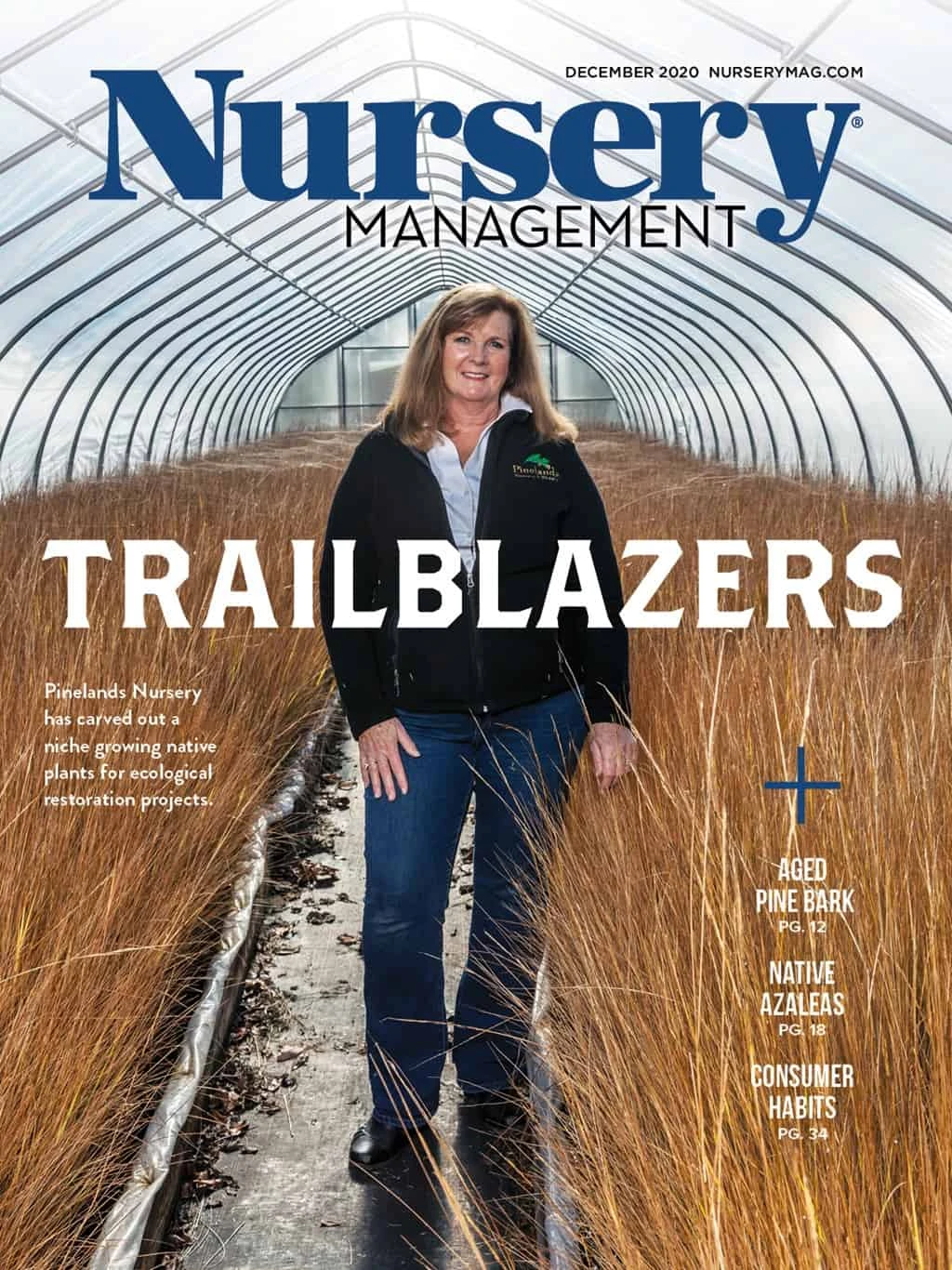

In the 1791 book “Travels” written by William Bartram, he described the Flame azalea (R. calendulaceum) as “This is the most gay and brilliant flowering shrub yet known.” Since the founding of Carolina Native, we use this quote, but it does not translate well. A few years ago, we welcomed a group of horticulturists and landscape architects from China. Thinking we would impress them, we used Google translate to produce an introduction and brief catalog in Chinese. As we handed it out, all our guests began to laugh. Humor usually starts things off well, and they all wanted to see the homosexual shrub. Of course, the word “gay” doesn’t translate properly. The joke was on us. But it did earn me two trips to China, a speaking engagement with the Chinese Association of Landscape Architects about North American native azaleas in Shanghai (intimidating), and a little business.
Indigenous azaleas are the gems of the native plant garden. And considering the rising awareness of all the ecological advantages of native plants in gardens and landscapes, it may be a good idea to gain some fundamental knowledge about these wonderful plants. I follow the lead of Clarence Towe in his book “American Azaleas” in terms of information and plant grouping.
There are 15 (do I hear 17?) American azaleas species, plus a few that have been added. And since these azaleas hybridize easily, some may say more. They are all deciduous, in the subgenus Pentanthera (five stamens) of the genus Rhododendron (being part of the Rhododendron genus confuses many). Like Mr. Towe, I will place these wonderful plants into five groups (plus one).
1) Western azalea (R. occidentale) is the only one from the West Coast. Found from southern Oregon down the coast of California to Mexico, this plant is stoloniferous. It can grow up to 30 feet with light pink flowers all the way to red in May to August. It’s reported that R. occidentale does not do well in the Eastern United States, but we have a few in production and will see for ourselves.

2) Rhodora (R. canadense) and Pinkshell (R. vaseyi) are non-fragrant pinks that are very different and found far away from one another. Rhodora is from the Northeast and is a stoloniferous low grower (3 feet). Easily identified by its small, some say grayish leaves, it blooms pink to purple in May at our nursery. Pinkshell is found above 4,000 feet in a few counties in Western North Carolina, usually blooms pink (sometimes white) from round and sticky buds before the leaves appear. It is easy to identify by its pointy leaves and bark that appears “shreddy.” Very open and airy but certainly doesn’t do well off the mountain.
3) Piedmont (R. canescens), Pinxter (R. periclymenoides formerly R. nudiflorum) and Roseshell (R. prinophyllum) are somewhat fragrant pink azaleas that cover the Eastern U.S. Piedmont, the southern one, grows up to 15 feet tall and is lightly fragrant. It’s very hardy, grows in many conditions and is found in USDA Zones 6-9. Also called hoary azalea, the blooms are light pink to sometimes white. Pinxter likes somewhat drier soils. It’s seen in all shades of pink with a particularly deeper pink in the throat in April to May. This azalea can be seen from the Deep South up to Cape Cod, and it’s hard in Zones 4-8. Roseshell doesn’t seem to like it hot, struggles and is slow in Western North Carolina. It can grow up to 8 feet tall and blooms in all shades of pink from May to June. The emerging leaves are coppery in color and covered with short hairs. It’s sometimes called downy or mountain pink. The fragrance in these plants pales in comparison to the plants in group 4.
4) Alabama (R. alabamense), Coastal (R. atlanticum), Sweet (R. arborescens) and Swamp (R. viscosum) have the whites that remind you what fragrant plants are all about. All of these are incredibly fragrant. Many times, you smell them before you see them and start searching for the source, then wonder where you can get one for your garden. One whiff and sold! Alabama azalea blooms white to white with yellow blotches in April through June. The large leaves can be semi glossy. Found in the deep south and hardy from Zones 6-8. Coastal is usually identified by its bluish leaves. Found along the Mid-Atlantic coast from Delaware to Georgia, it’s hardy in Zones 5-8. Flowers range from white to completely yellow from April to May. Sweet azaleas are named for their awesome fragrance. Fantastic white blooms, sometimes with yellow blotches, with very distinctive red pistils and filaments from April to May. Usually the glossy, deep-green leaves are a giveaway. Swamp azaleas can be found all over the Eastern U.S. It has smaller leaves, smaller white flowers, but still nicely fragrant with individual plants blooming all summer. Also called catch-fly and clammy azalea because the sticky, glandular hair can catch insects. We find all the whites to be hardy and easiest to grow in the nursery and landscape.

5) For a wide group of orange, yellow, and red blooming plants, look to Florida (R. austrinum), Oconee (R. flammeum), Flame (R. calendulaceum), Cumberland (R. cumberlandense), and Plumleaf (R. prunifolium). Florida likes it hot but has proven hardy even in the cold of the Midwest as seen at the planting at Taylor University in Indiana. Grows up to 15 feet tall and blooms fragrant yellow to pale orange early in March to April. Oconee is found in the area along the Oconee River in Georgia. It can be 6-8 feet tall and blooms from yellow to red in April. Being in western North Carolina, our favorite is the Flame azalea. Grown from seed, it can be yellow to bright orange in big trusses from April to July depending on your altitude. Sometimes it can be finicky when planted in the wrong spot. Flames can grow up to 12 feet tall and they are beautiful. Highly sought after in the Appalachian region and beyond. Performs in Zones 5 to 8. Cumberland (from the Cumberland Plateau) is usually confused with the Flame but has smaller flowers. The orange-to-red blooms are smaller in stature to the Flame. Plumleaf is sought after for its late bloom time. The blooms are beautifully dark orange to red and seen in August and September. Found in a small region on the Alabama-Georgia border and a prize in the garden. Beautiful purple leaves in the fall, it can be a big plant growing up to 20 feet tall.
6) Not new but recently recognized species are the Red Hill (R. colemanii) and May White azalea (R. eastmanii). Red Hill was recognized in 2008, found in Alabama, and was thought to be R. alabama. But it was found to bloom earlier (early May), has different colors, and has other distinctive traits leading to recognition. May Hill, found in South Carolina, was also thought to be an R. alabama but through the same type of scientific work, was named in 1999. Blooms with a yellow blotched white, fragrant blossom in mid-May and is found in a more neutral soil.
One of the wonderful elements of these plants can also present problems as a grower — they hybridize easily. It can lead to amazing natural collections as found on Gregory Bald and Hooper Bald in western North Carolina. But also leads azalea enthusiasts and collectors to travel far and wide on the hunt. The azalea garden on the Biltmore Estate is named after Chauncey Beadle. Beadle, appointed by Frederick Law Olmsted in 1890 to oversee the Biltmore Estate Nursery, eventually became estate manager until his death in 1950. He and his botanist friends Frank Crayton and William Knight, plus their driver Sylvester Owens, started searching in 1930. Calling themselves “the azalea hunters,” the four of them spent countless hours, weekends, and holidays searching the southeast for native azaleas, species and natural hybrids. Some of those plants can be seen on the Biltmore Estate today.

Those traditions are alive today. Azalea hunting is a regular feature of chapters of the Azalea Society of America. Earl Sommerville and Kelly Strickland hybrids, Ernest Koone of Lazy K Farms, Vivien Abney of East Fork Nursery, and others keep the tradition of searching for and cultivating native hybrids alive and well. Callaway Gardens, the Azalea collection at Taylor University, the National Azalea Repository at the N.C. Arboretum, as well as The Biltmore Estate, are among the gardens to see many of these plants in bloom.
Native azaleas are all over the eastern U.S., as are many hybrids, both man-made and found in nature. They are all true gems and can be the centerpiece of any garden, in particular native landscapes. The popularity of these plants by the home gardener, as well as landscape architects and designers, increases dramatically every season.

Explore the December 2020 Issue
Check out more from this issue and find your next story to read.
Latest from Nursery Management
- The HC Companies, Classic Home & Garden merge as Growscape
- Terra Nova releases new echinacea variety, 'Fringe Festival'
- Eason Horticultural Resources will now officially be known as EHR
- BioWorks receives EPA approval for new biological insecticide for thrips, aphids, whiteflies
- Ellen Mackenbach-Lakeman appointed new CEO of Dümmen Orange
- The Growth Industry Episode 3: Across the Pond with Neville Stein
- Southern Garden Tour sets 2025 dates for trial garden open houses
- New book explores plants that thrive in Rocky Mountains




